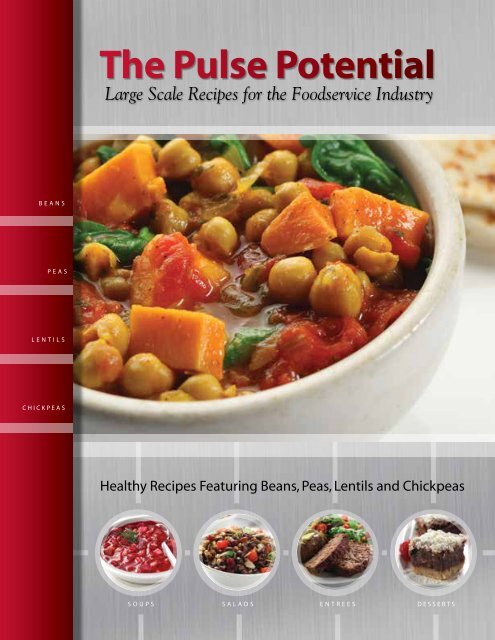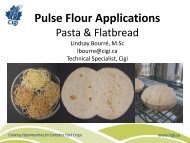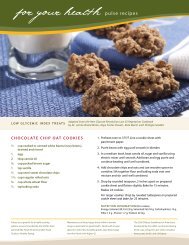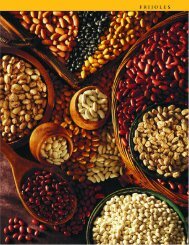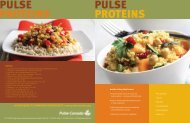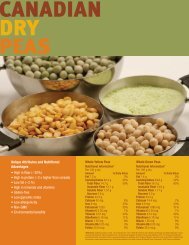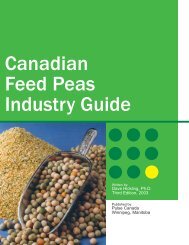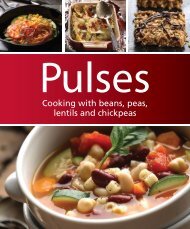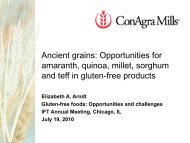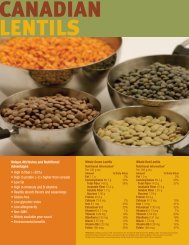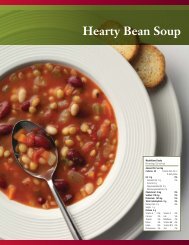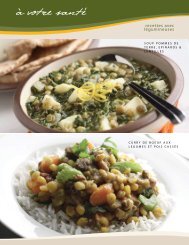Large Scale Recipe Manual - Pulse Canada
Large Scale Recipe Manual - Pulse Canada
Large Scale Recipe Manual - Pulse Canada
You also want an ePaper? Increase the reach of your titles
YUMPU automatically turns print PDFs into web optimized ePapers that Google loves.
The <strong>Pulse</strong> Potential<br />
<strong>Large</strong> <strong>Scale</strong> <strong>Recipe</strong>s for the Foodservice Industry<br />
BEANS<br />
PEAS<br />
LENTILS<br />
CHICKPEAS<br />
Healthy <strong>Recipe</strong>s Featuring Beans, Peas, Lentils and Chickpeas<br />
Soups<br />
Salads<br />
Entrees<br />
Desserts
Table of Contents<br />
Types of <strong>Pulse</strong>s 3<br />
What are <strong>Pulse</strong>s? 4<br />
What are the Health Benefits 4<br />
of <strong>Pulse</strong>s?<br />
Who Should Eat <strong>Pulse</strong>s? 5<br />
<strong>Pulse</strong>s and Important Nutrients 6<br />
<strong>Pulse</strong>s and Special Diets 6<br />
<strong>Pulse</strong>s and Digestion 7<br />
Ten Easy Ways to Add More 8<br />
<strong>Pulse</strong>s to Your Menu<br />
Storing and Cooking <strong>Pulse</strong>s 9<br />
Soaking Tips and Methods 9<br />
Baking Soda 9<br />
Cooking Tips and Methods 10<br />
<strong>Pulse</strong> Purée 10<br />
<strong>Pulse</strong> Flours and Fractions 10<br />
<strong>Recipe</strong> Cards<br />
Look for these Symbols in the<br />
included recipes<br />
Inside Panel<br />
Discover<br />
a tasty, nutritious and versatile<br />
food…pulses. Enjoyed for centuries<br />
by many cultures around the world,<br />
pulses make wonderful main<br />
dishes, soups, salads, appetizers,<br />
snacks and even baked goods!<br />
The 13 recipes included with this manual were developed<br />
by the Saskatoon Health Region (SHR). At the outset of the<br />
project, an on-line survey of 60 dietitians working in Canadian<br />
health care foodservice institutions was completed. The<br />
information gathered during this process was used as the basis<br />
for decisions regarding types of recipes, batch and portion<br />
sizes, costing, nutritional targets for different meal categories,<br />
and main dietary or health issues (e.g. fibre, sodium). Based<br />
on the survey, 94.7% of respondents said they were interested<br />
in increasing the use of pulses in their menu. Key nutrition<br />
considerations for the institutions were improving fibre<br />
content, and dealing with constipation.<br />
The SHR developed the recipes using scaled-up batch sizes.<br />
These recipes have been tested in both long term and acute<br />
care facilities in Saskatoon. For the taste panels, participants<br />
included residents and staff (dietitians, managers, supervisors,<br />
front line staff and visitors) from acute care, long term care,<br />
rural and urban health care facilities across Saskatchewan.<br />
<strong>Pulse</strong> <strong>Canada</strong> would like to acknowledge Vicki Dutton for<br />
initiating this project with the SHR. Since 1974, pulse crops<br />
have added value to Vicki’s farm in the Paynton, Saskatchewan<br />
area where she farms with her husband David. The lentil soup<br />
recipe in this manual was developed by the SHR based on one<br />
of Vicki’s own recipes.<br />
While this manual was originally developed by<br />
representatives from the health care industry, all recipes<br />
are suitable for any large scale foodservice operation.<br />
Vegetarian choice<br />
High fibre<br />
(4 grams or more per serving) <strong>Recipe</strong> Notes<br />
Freezes Well<br />
Gluten-Free<br />
Nutritional analysis was completed using the Hospitality Suite<br />
(Computrition) system used in the health region. Nutrient<br />
values for individual ingredients are from the Canadian Nutrient<br />
Database. Please note that the substitution of ingredients may<br />
occur to provide alternative results of sodium, fat and calories.<br />
For more information and recipes, visit www.pulsecanada.com<br />
Page 2
Types of <strong>Pulse</strong>s<br />
Peas<br />
Lentils<br />
Chickpeas<br />
Beans<br />
Yellow<br />
<strong>Large</strong> Green<br />
Other names: Laird-type,<br />
Masoor <strong>Large</strong> Green<br />
Garbanzo<br />
Other names: Kabuli, Bengal<br />
gram, Kabuli chana<br />
Navy<br />
Other names: White Pea,<br />
Alubia Chica<br />
Dark Red Kidney<br />
Green<br />
Red<br />
Other name: Masoor<br />
Desi<br />
Other names: Kala chana<br />
Cranberry<br />
Other names: Romano,<br />
Speckled Sugar, Borlotti<br />
Light Red Kidney<br />
Split Yellow<br />
French Green<br />
Other name: Dark Speckled<br />
Split Desi Chickpea<br />
Other name: Chana dal<br />
Pinto<br />
Split Green<br />
Split <strong>Large</strong> Green<br />
Other names: Yellow Split Lentil,<br />
Masoor dal<br />
Great Northern<br />
Other name: <strong>Large</strong> White<br />
Split Red<br />
Other name: Masoor dal<br />
Black<br />
Other names: Black Turtle,<br />
Preto<br />
Dehulled Red<br />
Other names: Football,<br />
Masoor dal<br />
Page 3
What are <strong>Pulse</strong>s?<br />
<strong>Pulse</strong>s are also known and often referred to as legumes.<br />
<strong>Pulse</strong> is the term for the edible seeds of legumes<br />
(plants with a pod), which includes:<br />
• Dry peas<br />
• Lentils<br />
• Dry beans<br />
• Chickpeas (garbanzo beans)<br />
<strong>Pulse</strong>s do not include fresh green beans or peas. Although<br />
they are related to pulses because they are also edible seeds<br />
of podded plants, soybeans and peanuts differ because they<br />
have a much higher fat content, whereas pulses contain<br />
virtually no fat.<br />
What are the Health Benefits of <strong>Pulse</strong>s?<br />
<strong>Pulse</strong>s are nutritional powerhouses! They are rich in protein,<br />
fibre and complex carbohydrates, low in fat and sodium and<br />
contain a variety of vitamins and minerals. These nutrients<br />
make pulses an important part of any healthy diet, including<br />
the gluten-free diet.<br />
• <strong>Pulse</strong>s are a good source of plant protein. Eating pulses<br />
with grains, nuts or seeds ensures a high quality, complete<br />
protein.<br />
• <strong>Pulse</strong>s are very high in fibre. They contain both soluble<br />
and insoluble fibre. Soluble fibre helps lower cholesterol<br />
and other blood lipid levels, while insoluble fibre helps with<br />
digestion and maintaining regular bowel movements.<br />
High-fibre diets may also reduce the risk of certain cancers.<br />
Fibre-rich foods like pulses are often more filling than other<br />
foods, helping you keep full until your next meal, an added<br />
bonus for those watching their weight.<br />
In order to avoid digestive issues when adding high-fibre<br />
foods like pulses to your diet, gradually increase your intake<br />
and make sure you drink enough water!<br />
• <strong>Pulse</strong>s have a low glycemic index. Most of the<br />
carbohydrates in pulses are fibre and resistant or slowly<br />
digested starch that prevent blood sugars from rising quickly<br />
after a meal or snack. Eating foods with a low glycemic index<br />
can help you to control your blood glucose levels, maintain<br />
high energy levels throughout the day, control your appetite<br />
and lower your risk of developing type 2 diabetes.<br />
• <strong>Pulse</strong>s are low in fat and sodium making them a<br />
heart healthy option. <strong>Pulse</strong>s are also free of trans fats<br />
and cholesterol.<br />
• <strong>Pulse</strong>s are an excellent source of folate, a B vitamin, which<br />
has been shown to lower homocysteine levels. Evidence<br />
suggests that high levels of homocysteine (a type of protein)<br />
damages the lining of arteries and promotes plaque buildup<br />
and blood clots. Over time, this damage can slow or block<br />
blood flow to the heart or brain causing a heart attack or<br />
stroke. Folate also plays a role in cell development, which is<br />
especially important during infancy and pregnancy when<br />
new cells are rapidly being formed.<br />
• <strong>Pulse</strong>s are a good source of other B vitamins such as<br />
thiamin (B1), riboflavin (B2), niacin (B3), pantothenic acid (B5)<br />
and pyridoxine (B6). B vitamins are essential for healthy cells<br />
and help our bodies create energy from foods.<br />
• <strong>Pulse</strong>s are high in potassium, a mineral which<br />
helps regulate fluid balance and maintain normal blood<br />
pressure.<br />
• <strong>Pulse</strong>s are a good source of various minerals such as iron,<br />
zinc, magnesium and calcium that play important roles in<br />
the body.<br />
Page 4
Who Should Eat <strong>Pulse</strong>s?<br />
Everyone can benefit from eating pulses. <strong>Pulse</strong>s are high in<br />
fibre and complex carbohydrates, and are a good source of<br />
protein and are low in fat. These nutrients make pulses an<br />
important part of any healthy diet and can help maintain a<br />
healthy body weight.<br />
<strong>Pulse</strong>s have additional benefits for people who:<br />
• Are overweight<br />
• Have diabetes<br />
• Have high blood<br />
cholesterol levels<br />
• Tend to be constipated<br />
• Have celiac disease<br />
• Are vegetarians<br />
<strong>Pulse</strong>s are gluten-free and are a great alternative to wheatbased<br />
products. They add fibre, protein, and many vitamins<br />
and minerals that may be lacking in a gluten-free diet.<br />
A healthy vegetarian diet should include a variety of peas,<br />
beans, lentils and chickpeas in place of beef, pork, chicken and<br />
fish. Eating pulses with a grain, such as wheat, rice, or oats,<br />
ensures a high quality protein.<br />
Examples are:<br />
• Hummus with pita bread<br />
• Lentils with rice<br />
• Baked beans with toast<br />
Page 5
<strong>Pulse</strong>s Provide<br />
Important Nutrients<br />
<strong>Pulse</strong>s are a very high source of fibre. They contain both<br />
soluble and insoluble fibres. Soluble fibre helps lower blood<br />
cholesterol levels, while insoluble fibre helps with digestion as<br />
well as maintaining regular bowel movements. Fibre-rich foods<br />
like pulses are often more filling than other foods, helping to<br />
increase feelings of fullness and reduce appetite until the next<br />
meal. Current recommendations from the United States National<br />
Academy of Sciences, Institute of Medicine, suggest that adults<br />
should consume 20-35 grams of dietary fibre per day, but on<br />
average, North Americans consume less than 50% of the dietary<br />
fibre levels recommended. Eating just ½ cup (125 mL) of pulses<br />
per day provides 3-6.5 g fibre. With their high fibre levels, pulses<br />
are a very healthy food choice!<br />
Besides fibre, pulses contain other complex carbohydrates like<br />
resistant and slowly digestible starch as well as oligosaccharides.<br />
Resistant starch (RS) refers to carbohydrates that are not absorbed<br />
in the small intestine because they are resistant to digestion by<br />
enzymes. Oligosaccharides are carbohydrate compounds that<br />
are smaller in size than fibre and starch but are larger than simple<br />
sugars. RS and oligosaccharides have similar effects in the body<br />
as fibre, including improved colonic and digestive health and<br />
management of blood sugar and body weight. Slowly digestible<br />
starch (SDS) is digested completely but at a slower rate than other<br />
starches and sugars. This means that SDS gives a better blood<br />
sugar response after eating and can also increase satiety<br />
or feelings of fullness.<br />
<strong>Pulse</strong>s are somewhat unique as a plant food because in addition<br />
to high amounts of fibre and complex carbohydrates, pulses<br />
typically contain about twice the amount of protein found in<br />
whole grain cereals like wheat, oats, barley and rice. <strong>Pulse</strong>s also<br />
have higher amounts of the essential amino acid lysine whereas<br />
cereals have higher amounts of the essential amino acids<br />
methionine and cysteine, so blending pulses with cereals or nuts<br />
results in a better quality protein that contains all essential amino<br />
acids in appropriate amounts. This combination is particularly<br />
important for people eating vegetarian or vegan diets.<br />
<strong>Pulse</strong>s have a low glycemic index. Most of the carbohydrates in<br />
pulses are fibre in starch that prevent blood sugars from rising<br />
quickly after a meal or snack.<br />
<strong>Pulse</strong>s are nutrient dense meaning they provide high amounts of<br />
vitamins and minerals for the amount of calories. Some of the<br />
important vitamins and minerals in pulses include iron, potassium,<br />
phosphorous, zinc, folate, thiamin and other B vitamins.<br />
<strong>Pulse</strong>s are low in fat, saturated fat and are free of trans fats<br />
and cholesterol.<br />
<strong>Pulse</strong>s are Appropriate<br />
for Special Diets<br />
A healthy vegetarian diet should include a variety of pulses<br />
including peas, beans, lentils and chickpeas as protein-rich plant<br />
foods. Eating pulses along with cereal grains such as wheat, rice,<br />
or oats, ensures a high quality protein.<br />
<strong>Pulse</strong>s are a heart-healthy food. Regular consumption of pulses<br />
can lower blood cholesterol, a major risk factor for heart disease.<br />
<strong>Pulse</strong>s are a good food choice for diabetes and research has<br />
shown that pulse consumption can help with managing blood<br />
sugar levels.<br />
<strong>Pulse</strong>s can help maintain a healthy body weight. Research<br />
suggests that eating pulses may help to increase satiety or<br />
feelings of fullness over the short term. Over longer periods,<br />
regular pulse consumption as part of a reduced calorie diet may<br />
contribute to weight loss.<br />
<strong>Pulse</strong>s are gluten-free and can be eaten by people with celiac<br />
disease. <strong>Pulse</strong>s are a great alternative to wheat-based products.<br />
They add fibre, protein, and many vitamins and minerals that<br />
may be lacking from a gluten-free diet.<br />
Page 6
<strong>Pulse</strong>s and Digestion<br />
Some carbohydrates found in pulses produce gas and bloating<br />
for some people, similar to the effects produced by certain other<br />
foods (e.g. cabbage, broccoli, and other vegetables and fruits).<br />
Eating pulses often allows your gut to adapt to the higher fibre<br />
and carbohydrates, decreasing these effects over time.<br />
A study published in the Nutrition Journal reported that for<br />
participants who ate ½ cup of pinto beans, black beans or<br />
black eyed peas every day for 8 to 12 weeks, less than half<br />
reported increased flatulence during the first week of the<br />
study and by the second or third week, 70% or more of the<br />
participants felt that any increase in flatulence had dissipated.<br />
Interestingly, 3-11% of participants reported increased<br />
flatulence when eating the control foods (canned green beans,<br />
carrots, chicken soup) which did not contain any known<br />
flatulence-producing compound.<br />
Another study published in Food Research International in<br />
2010 found similar results for healthy male participants who<br />
ate soups made from either chickpeas, lentils, or dry peas<br />
versus a potato control every day for a period of 28 days. In this<br />
study, pulse consumption was not associated with significant<br />
changes in participants’ perception of the occurrence or<br />
severity of flatulence. There were also no significant differences<br />
in abdominal discomfort over time or between any of the<br />
treatments.<br />
The primary flatulence-producing compounds in pulses are<br />
the oligosaccharides including raffinose and stachyose which<br />
are carbohydrate compounds that are not readily digested<br />
by humans because of their chemical structure. Soaking and<br />
rinsing dry beans before cooking, as well as rinsing of canned<br />
beans, can reduce the levels of these hard to digest sugars.<br />
It is also important to note that gas production is a normal<br />
physiological process that, to some extent, aids in digestion by<br />
softening and helping to move stools through the colon.<br />
Page 7
Ten Easy Ways to Add More <strong>Pulse</strong>s to Your Menu<br />
<br />
<br />
<br />
<br />
<br />
<br />
<br />
<br />
<br />
<br />
Add chickpeas to any green salad to increase<br />
protein without the fat.<br />
Mix black beans into salsa for a high fibre dip.<br />
Add whole chickpeas or lentils to pasta sauce or<br />
chili to increase fibre.<br />
Include black beans in omelettes or quesadillas to<br />
add fibre.<br />
Add puréed* chickpeas or lentils to meatloaf to<br />
reduce the amount of ground beef and boost<br />
fibre.<br />
Replace half the butter or oil when baking with a<br />
lentil purée* to lower the fat.<br />
Add cooked chickpeas to soups to increase<br />
protein.<br />
Add beans to rice side dishes to make a tasty,<br />
complete protein. This combination will also<br />
boost the mineral and vitamin content of the dish.<br />
Mix puréed* chickpeas or white beans with fresh<br />
or dry herbs and use as a sandwich spread.<br />
Serve chickpea hummus or bean dip with<br />
vegetables as a feature appetizer.<br />
*See instructions for making puréed pulses on page 10.<br />
Page 8
Storing and Cooking<br />
<strong>Pulse</strong>s<br />
Dry pulses will keep for years if stored in tightly-covered<br />
containers in a cool, dark, dry place. However, it is best<br />
to use pulses within a year of purchasing. The longer<br />
a pulse is stored, the drier it becomes, which increases<br />
the cooking time required.<br />
Canned pulses are very convenient as they are ready-touse.<br />
Always rinse and drain canned pulses before using.<br />
This simple step reduces the sodium content of canned<br />
pulses by more than 40%. 1 Canned pulses store well in<br />
cool, dry places. They may be stored for up to one year.<br />
1<br />
Duyff RL, Mount JR, Jones JB. Sodium reduction in canned beans after draining,<br />
rinsing. Journal of Culinary Science & Technology 2011;9(2):106-12.<br />
Soaking Tips and Methods<br />
• Dry beans, whole peas and chickpeas must be soaked<br />
before cooking.<br />
• Dry lentils and split peas do not need to be soaked, but<br />
should be rinsed before cooking.<br />
For every 1 cup (250 mL) of pulses, soak with 3 cups (750 mL)<br />
water. Whole peas can be soaked for 1-2 hours. Beans and<br />
whole chickpeas require longer soaking than whole peas<br />
(e.g. min. 4 hours, or preferably soak for 8 hours or overnight).<br />
Always discard the soaking water by putting pulses into<br />
a strainer and rinsing them well. This washes away the<br />
carbohydrates and sugars that cause gas.<br />
1<br />
Open a can of beans,<br />
pour the contents into<br />
a colander and drain for<br />
two minutes.<br />
SOAKING METHOD<br />
FOR DRY PULSES<br />
Long, cold soak or overnight<br />
INSTRUCTIONS<br />
• Let stand 12 hours or overnight<br />
in refrigerator<br />
Quick soak<br />
2<br />
Rinse the beans under<br />
tap water for at least<br />
10 seconds.<br />
• Bring pulses and water to boil<br />
in a saucepan<br />
• Boil gently for 2 minutes<br />
• Remove from heat, cover,<br />
and let stand for 1 hour<br />
Microwave soak<br />
3<br />
Allow beans to drain for<br />
two more minutes.<br />
• Combine pulses and water<br />
in microwavable dish<br />
• Cover and microwave on high<br />
for 10-15 minutes<br />
• Let stand for 1 hour<br />
Following these directions can further decrease the sodium content of the recipes included in this manual.<br />
Baking soda<br />
Some recipes call for baking soda (sodium bicarbonate) to shorten the<br />
cooking process, especially if using hard water. Baking soda increases<br />
the absorption of water, but it also destroys thiamin, an important B<br />
vitamin found in pulses. Baking soda may also make the texture of<br />
pulses too soft, an undesired side effect. Therefore, using baking soda<br />
to aid in cooking pulses is not recommended. If hard water is your<br />
only choice and you need to add baking soda, limit the amount to<br />
1/8 teaspoon per 2 cups (0.5 ml per 500 ml) water.<br />
Page 9
Cooking Tips and Methods<br />
• Make sure your cooking pot is big enough, as pulses<br />
double or triple in size during cooking.<br />
• To prevent foaming, add 1 teaspoon (5 mL) of oil to the<br />
cooking water.<br />
• Seasonings like garlic, onion or herbs can be added while<br />
cooking pulses.<br />
• Always cook pulses slowly, as cooking them too quickly<br />
can break the seed coats.<br />
• Cooking time guidelines are provided below. Note that<br />
cooking times may vary based on a number of factors,<br />
including age of the pulses, elevation, water hardness, etc.<br />
• The goal is to cook pulses until they are tender. To achieve<br />
optimal cooking, pulses can be tested as they near the<br />
prescribed cooking time.<br />
• Tomatoes, vinegar or other acidic ingredients should be avoided<br />
until pulses are tender. Acids slow the cooking process.<br />
• Beans naturally have a toxic compound in them called<br />
phytohemagglutinin. This is destroyed by adequate cooking.<br />
For slow cooker recipes, pre-soaked beans should be boiled for<br />
10-12 minutes in fresh water before adding to the crock pot.<br />
<strong>Pulse</strong> Purée<br />
Purées are useful for dips, spreads and some baked goods.<br />
To make a purée:<br />
• Place cooked or rinsed and drained canned pulses<br />
into a food processor.<br />
• For every 1 cup (250 mL) cooked pulses, add approximately<br />
¼ cup (50 mL) water.<br />
• Blend to make a smooth purée, with a consistency<br />
like canned pumpkin.<br />
• If needed, add additional water 1 tablespoon (15 mL)<br />
at a time.<br />
• Purées can be placed in plastic bags and kept for<br />
several months in the freezer.<br />
<strong>Pulse</strong> Flours and Fractions<br />
<strong>Pulse</strong> flours and fractions like pea fibre can be used in a<br />
variety of recipes including cakes, muffins and cookies. Using<br />
pulse flours (pea flour, bean flour, chickpea flour, lentil flour)<br />
and fraction ingredients (pea fibre, starch and protein) can<br />
boost the protein, fibre and vitamin and mineral content of<br />
many recipes. For more<br />
information on using pulse<br />
ingredients in gluten-free<br />
foods, see <strong>Pulse</strong>s and the<br />
Gluten-Free Diet: Cooking<br />
with Beans, Peas, Lentils PULSES<br />
and Chickpeas available at and the Gluten-Free Diet<br />
COOKING WITH BEANS, PEAS, LENTILS AND CHICKPEAS<br />
www.pulsecanada.com.<br />
For information on<br />
ingredient suppliers,<br />
contact <strong>Pulse</strong> <strong>Canada</strong> or<br />
your provincial grower<br />
association (details on<br />
back cover).<br />
Cooking methods & times for dry pulses<br />
Beans<br />
Whole Peas<br />
Split Peas<br />
Whole Lentils<br />
Split Lentils<br />
Whole Chickpeas<br />
Split Chickpeas<br />
Rinse Yes Yes Yes Yes Yes Yes Yes<br />
Soak Yes Yes No No No Yes No<br />
Amount of water per<br />
1 cup (250 mL) dry pulses<br />
2½-3 cups<br />
(625 to 750 mL)<br />
2½-3 cups<br />
(625 to 750 mL)<br />
2 cups<br />
(500 mL)<br />
2½-3 cups<br />
(625 to 750 mL)<br />
2 cups<br />
(500 mL)<br />
2½-3 cups<br />
(625 to 750 mL)<br />
2 cups<br />
(500 mL)<br />
Cooking time 1-1½ hrs. 1½-2 hrs. 45 min. 10-30 min. 5-15 min. 1½-2 hrs. ½-1 hrs.<br />
Pressure cook time<br />
(at 15 psi)* 8-12 min. 5-7 min. No No No 12-15 min. 5-7 min.<br />
Yield from 1 cup (250 mL)<br />
dry pulses<br />
2½ cups<br />
(625 mL)<br />
2½ cups<br />
(625 mL)<br />
2 cups<br />
(500 mL)<br />
2½ cups<br />
(625 mL)<br />
2 cups<br />
(500 mL)<br />
2½ cups<br />
(625 mL)<br />
2 cups<br />
(500 mL)<br />
* Pressure cook times are for pulses that have been pre-soaked and are based on the “quick” or “cold water” release method,<br />
in which the pressure cooker is placed under cold water after removing from the burner to lower pressure. If a “natural”<br />
release method is used instead (pressure is left to fall on its own), the cooking times need to be reduced.<br />
Page 10
<strong>Pulse</strong>s for a healthy planet<br />
When you’re eating products made from pulses, you’re making<br />
a choice that is good for the environment. <strong>Pulse</strong>s take less energy<br />
to grow than other crops, and produce fewer greenhouse gases.<br />
<strong>Pulse</strong> crops are also one of the most environmentally-friendly<br />
sources of protein, contributing to sustainable food production<br />
by protecting and improving soil and water resources.<br />
Page 11
pulse <strong>Canada</strong><br />
<strong>Pulse</strong> <strong>Canada</strong> is the national association representing pulse growers, processors and traders. Direction and funding is provided by Alberta <strong>Pulse</strong> Growers Commission,<br />
Saskatchewan <strong>Pulse</strong> Growers, Manitoba <strong>Pulse</strong> Growers Association, the Ontario Bean Producers Marketing Board, Ontario Coloured Bean Growers and the pulse processors<br />
and exporters that are members of the Canadian Special Crops Association (CSCA). <strong>Pulse</strong> <strong>Canada</strong> provides its members with a single, unified voice on national and<br />
international issues affecting the pulse industry. Areas of focus include market access and transportation, as well as positioning pulses as a cornerstone ingredient for<br />
healthier foods and a more sustainable environment.<br />
<strong>Pulse</strong> <strong>Canada</strong>’s members include:<br />
The Ontario Coloured Bean Growers Association represents<br />
450 producers in Ontario who grow a variety of coloured<br />
beans including Kidney, Cranberry, Blacks, Otebos,<br />
Pintos and Adzuki Beans. Our mandate includes product<br />
promotion, consumer education, agronomy and production research and is<br />
funded by a non-refundable check-off / tonne of production. Formed in 1986, the<br />
association in based in Mitchell, Ontario and is very active in lobbying the provincial<br />
and federal governments for programs to benefit our producers.<br />
To learn more about the Ontario Coloured Bean Growers Association,<br />
visit www.ontariobeans.on.ca<br />
Saskatchewan <strong>Pulse</strong> Growers represents over 18,000 pulse<br />
crop producers in Saskatchewan. Accountable to growers and<br />
funded through a mandatory check-off, SPG has a producerelected<br />
board of directors comprised of seven pulse growers.<br />
With a legislated mandate to build a prosperous pulse industry in Saskatchewan, SPG<br />
invests in research and market development and promotes sustainable innovation,<br />
growth and success through leadership, collaboration and support. Today, Saskatchewan<br />
is the heart of <strong>Canada</strong>’s pulse industry. We produce 99% of the Canadian lentil crop,<br />
65% of the Canadian pea crop, and 99% of the Canadian chickpea crop and there are<br />
over 100 special crop processors in Saskatchewan.<br />
To learn more about Saskatchewan <strong>Pulse</strong> Growers, visit www.saskpulse.com<br />
The Ontario Bean Producers’ Marketing Board (OBPMB) is<br />
a not for profit organization that represents the interests of<br />
approximately 1,000 farmers in Ontario that grow White Pea<br />
Beans (commonly found on store shelves as baked beans or<br />
beans in tomato sauce). Adapted varieties of White Pea Beans<br />
are grown throughout Ontario from the deep southwest – Harrow/Windsor area to<br />
the opposite end of the province in the Ottawa valley. Board operations are funded<br />
through a grower-licensing fee that is assessed against production. Revenues<br />
are allocated to prioritized strategic areas such as research, communications,<br />
promotions and marketing.<br />
To learn more about OBPMB, visit www.ontariobeans.on.ca<br />
The Alberta <strong>Pulse</strong> Growers Commission (APG) represents 4,700<br />
Alberta farmers who grow peas, beans, chickpeas, lentils and faba<br />
beans. It is a producer-driven, not-for-profit, organization funded<br />
by a refundable levy deducted at the point of pulse crop sale. Our<br />
mission is “To provide leadership, increasing the competitiveness,<br />
profitability, and sustainability of pulse production as well as promoting health and<br />
environmental benefits of pulses.” The Alberta pulse industry has grown from its<br />
inception, in the early 1980s, to one where primary production contributed<br />
$137 million to the Alberta economy in 2010.<br />
To learn more about APG, visit www.pulse.ab.ca<br />
Manitoba<br />
<strong>Pulse</strong> Growers<br />
Association Inc.<br />
The Manitoba <strong>Pulse</strong> Growers Association (MPGA) represents<br />
3,000 farmers in Manitoba who grow edible beans, peas,<br />
lentils, chickpeas, faba beans and soybeans. The organization<br />
is funded by a 0.5% check off levied against the sales<br />
of these crops. MPGA’s mission is to provide Manitoba<br />
pulse grower members with production knowledge and<br />
market development support, through focused research, advocacy and linkages<br />
with industry partners. MPGA’s focus areas include research, market development,<br />
advocacy and communication.<br />
To learn more about MPGA, visit www.manitobapulse.ca<br />
The Canadian Special Crops Association<br />
(CSCA) is a national trade association<br />
established in 1987. It represents companies<br />
involved in the merchandising of Canadian pulse and special crops, including bean,<br />
chickpea, lentil, pea, canary seed, buckwheat, sunflower seed and mustard seed.<br />
The CSCA currently has more than 110 members, ranging from large multi national<br />
organizations to single-plant processors. Together they represent more than 85%<br />
of the pulse and special crops produced in <strong>Canada</strong>.<br />
To learn more about CSCA, visit www.specialcrops.mb.ca<br />
To learn more about <strong>Pulse</strong> <strong>Canada</strong>, visit our website at www.pulsecanada.com<br />
<strong>Pulse</strong> <strong>Canada</strong><br />
1212-220 Portage Avenue<br />
Winnipeg, Manitoba, <strong>Canada</strong> R3C 0A5<br />
Telephone: 204.925.4455<br />
Fax: 204.925.4454<br />
Email: office@pulsecanada.com<br />
Web: www.pulsecanada.com<br />
This material has been made possible through<br />
Agriculture and Agri-Food <strong>Canada</strong>’s Agricultural<br />
Flexibility fund, as part of <strong>Canada</strong>’s Economic<br />
Action Plan.<br />
Printed 01/13 © <strong>Pulse</strong> <strong>Canada</strong>


